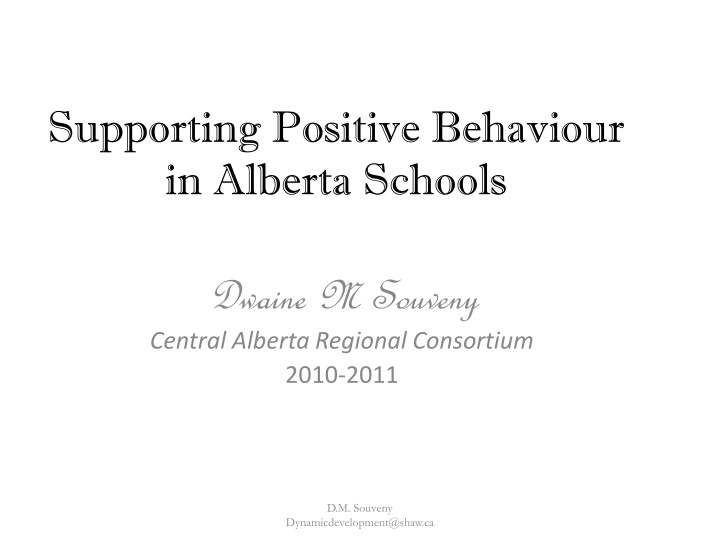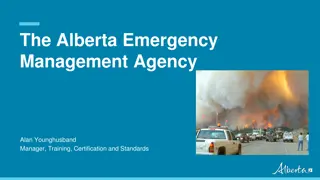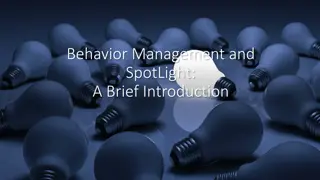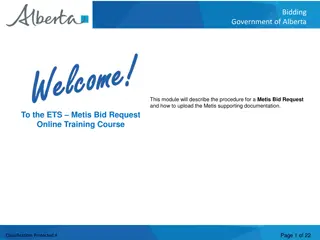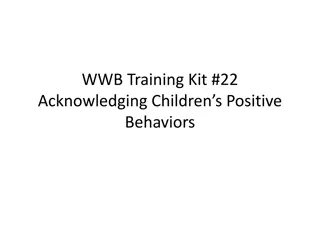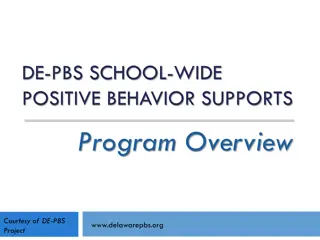Supporting Positive Behavior in Alberta Schools: Key Elements and Strategies
This content discusses strategies for supporting positive behavior in schools, focusing on key elements such as positive relationships, learning environment, differentiated instruction, understanding student behavior, and social skills instruction. It emphasizes the importance of positive reinforcement and provides practical tasks for identifying undesirable social behaviors and creating alternative scripts. The goal is to help students develop a clear understanding of what constitutes positive behavior and the importance of reinforcement.
Download Presentation

Please find below an Image/Link to download the presentation.
The content on the website is provided AS IS for your information and personal use only. It may not be sold, licensed, or shared on other websites without obtaining consent from the author.If you encounter any issues during the download, it is possible that the publisher has removed the file from their server.
You are allowed to download the files provided on this website for personal or commercial use, subject to the condition that they are used lawfully. All files are the property of their respective owners.
The content on the website is provided AS IS for your information and personal use only. It may not be sold, licensed, or shared on other websites without obtaining consent from the author.
E N D
Presentation Transcript
Supporting Positive Behaviour in Alberta Schools Dwaine M Souveny Central Alberta Regional Consortium 2010-2011 D.M. Souveny Dynamicdevelopment@shaw.ca
Supporting Positive Behaviour in Alberta Schools Key Element # 6 Positive Reinforcement February 15, 2011 Dwaine M Souveny Central Alberta Regional Consortium 2010-2011 D.M. Souveny Dynamicdevelopment@shaw.ca
Supporting Positive Behaviour In Alberta Schools (2008) A School Wide Approach A Classroom Approach An Intensive Individualized Approach D.M. Souveny Dynamicdevelopment@shaw.ca
Supporting Positive Behaviour In Alberta Schools 10 Key Elements D.M. Souveny Dynamicdevelopment@shaw.ca
Supporting Positive Behaviour in Alberta Schools 10 Key Elements Key Element 1: Positive Relationships Key Element 2: Learning Environment Key Element 3: Differentiated Instruction (DI) Key Element 4: Understanding Student Behaviour Key Element 5: Social Skills Instruction D.M. Souveny Dynamicdevelopment@shaw.ca
Workshop Task Identify a specific undesirable social behaviour: 1) Write a social script to describe the situation 2) Write an alternative social script to indicate what to do in a subsequent situation 3) Present and practise the script with the student Homework D.M. Souveny Dynamicdevelopment@shaw.ca
Motivation Motivation only enables us to do what we are already capable of doing. D.M. Souveny Dynamicdevelopment@shaw.ca
So, What Do Our Students Need to Know? Students need to have a clear idea of what the positive behaviour looks like. E.g.. Being prepared for class, sitting quietly, acting appropriately in the hallway. Quick Review 1. Positively Stated 2. Directly Taught Students need to know that once they perform the positive behaviours that reinforcement will follow. D.M. Souveny Dynamicdevelopment@shaw.ca
A School-wide Approach An effective school-wide plan includes opportunities for positive reinforcement of positive behaviours The biggest factor in the success of a positive reinforcement system is consistency among the adults in the school. D.M. Souveny Dynamicdevelopment@shaw.ca
Criteria for Successful Systems Includes all students Uses recognition and rewards that students want and value Use public recognition to highlight models for other students Recognize everyone Increase reinforcement before and during the times that are most difficult. E.g.. before holidays, traumatic events D.M. Souveny Dynamicdevelopment@shaw.ca
Positive Reinforcement: Classroom Procedures Kevin is frequently out of his desk so are many of the others in the class - What is 1 thing that you could do on a classroom basis to promote the desired behaviour? ________________________________ ________________________________ ________________________________ ________________________________ ________________________________ ________________________________ D.M. Souveny Dynamicdevelopment@shaw.ca
Effects on the Learning Process Positive Reinforcement assists in the process of learning new, more appropriate behaviours to replace problem behaviours or long term habits. Positive Reinforcement is especially important in motivating students to interact with peers and complete academic activities. D.M. Souveny Dynamicdevelopment@shaw.ca
What is Positive Reinforcement? Positive Reinforcement occurs as a result of presenting a stimulus which increases or maintains behaviour it follows. Huh??? Example: After receiving verbal praise for the completion of his homework, Johnny completed it every day for a week. D.M. Souveny Dynamicdevelopment@shaw.ca
Creating Choices With Creative Consequences: Positive Consequences Positive consequences = something the child wants that you feel comfortable giving Catch the child displaying the desired behaviour and deliver the positive consequence Set up opportunities to ensure that the child receives the positive consequence D.M. Souveny Dynamicdevelopment@shaw.ca
Activity: Creating a List of Positive Reinforcement Using one of the students that you work with, develop a Reinforcement Menu. The menu should reflect the student s personal likes. The menu should include things that the student enjoys doing, things they like to get, and areas of special interest. D.M. Souveny Dynamicdevelopment@shaw.ca
Types of positive reinforcement What are some ways that you use to motivate students through positive reinforcement? ________________________________ ________________________________ ________________________________ ________________________________ ________________________________ ________________________________ Activity D.M. Souveny Dynamicdevelopment@shaw.ca
Examples of Reinforcement 1. Praise and demonstration of approval 2. Nonverbal gestures such as smiling 3. Points can be earned to earn rewards or privileges 4. Breaks where activities are reinforcing e.g.. extra computer time 5. Many More . D.M. Souveny Dynamicdevelopment@shaw.ca
Short Term vs. Long Term Reinforcement 1. Short Term Reinforcement- are reinforcers that can be immediately applied. E.g.. games, breaks, and free reading 2. Long Term Reinforcement- are reinforcers that can be delayed such as pizza party, movie, or an extra recess. E.g.. Ice Cream Math, Picnics, Popcorn Party D.M. Souveny Dynamicdevelopment@shaw.ca
Developing Effective Reinforcement What is the Purpose? To send a clear and consistent message that desirable behaviour leads to positive consequences and problem behaviour leads to negative consequences. D.M. Souveny Dynamicdevelopment@shaw.ca
Activity: Using Positive Reinforcement to Develop Positive Behaviours 1. Identify a behaviour that your student demonstrates that you would like to see improve or change. 2. Note what you would like to see instead (replacement behaviour). 3. Write down how you could use positive reinforcement to increase your student s use of the replacement behaviour. D.M. Souveny Dynamicdevelopment@shaw.ca
Reinforcing Activity Replacement Behaviour Replacement Behaviour __________________ Reinforcement ___________________ __________________ ___________________ __________________ ___________________ __________________ ____________________ __________________ ____________________ D.M. Souveny Dynamicdevelopment@shaw.ca
Positive Reinforcement It should be carefully planned, including the process of presentation, timing, amount, and type. Positive Reinforcement could be adult or peer attention, a token, activities, or free time. D.M. Souveny Dynamicdevelopment@shaw.ca
Using Positive Reinforcements 1. 2. Deliver consequences frequently Deliver consequences consistently and as immediate as possible Emphasize social reinforcement vs. tangible reinforcement Have some delayed and longer term reinforcements Vary reinforcements Maintain consistent criteria for reinforcement 3. 4. 5. 6. D.M. Souveny Dynamicdevelopment@shaw.ca
Positive Reinforcement Rule of Thumb #1: Reinforce the behaviour that you want to see. The careful and consistent use of positive reinforcement for demonstrating expected behaviours is the best strategy to establish and maintain expected behaviour. D.M. Souveny Dynamicdevelopment@shaw.ca
Positive Reinforcement Rule of Thumb #2: Be cautious about inadvertently reinforcing an undesired behavioural sequence. D.M. Souveny Dynamicdevelopment@shaw.ca
Activity What is the problem with the following sequences? 1) Every time that Johnny does not know how to do a task or is off task when the instructions are given the EA tells him what to do. 2) Peter, who has Autism, sent out of the room whenever he becomes agitated 3) Betty gets into a verbal confrontation with Sally she is sent to the principal s office to work during the time in the principal s office she completes her homework D.M. Souveny Dynamicdevelopment@shaw.ca
Positive Reinforcement Rule of Thumb #3: Ensure that the student receives positive reinforcement Most behavioural programs fail to work because the student does not obtain the positive reinforcement indicated for them D.M. Souveny Dynamicdevelopment@shaw.ca
Remember The ratio of positive reinforcement delivered for good behaviours and through non- contingent attention should exceed the attention for problem behaviour by at least 4:1 D.M. Souveny Dynamicdevelopment@shaw.ca
What is Negative Reinforcement? Negative reinforcement increases behaviour as a result of removing aversive or unwanted events following specified behaviours. Huh??? Example: a) Taking aspirin to relieve headache b) Faking a Stomach Ache to Avoid School D.M. Souveny Dynamicdevelopment@shaw.ca
What do both Positive and Negative Reinforcement Do? 1. Both Positive and Negative Reinforcement increase or maintain behaviours that it follows. 2. Positive Reinforcement=to get/access something 3. Negative Reinforcement=to escape/avoid something Remember: What is important is the EFFECT on the behaviour. If the behaviour decreases, then the consequence is not reinforcing. D.M. Souveny Dynamicdevelopment@shaw.ca
Self-Monitoring This is the process where the student learns to track his or her own performance by documenting incidences of identified behaviours. Benefits include: a) Awareness of own behaviour b) Become pare of their own behaviour intervention c) Can provide their own positive reinforcement or consequences D.M. Souveny Dynamicdevelopment@shaw.ca
Positive Reinforcement Procedures Are Used To: 1. Teach new or positive behaviours 2. Encourage infrequent or non-fluent behaviours 3. Establish positive relationships with students 4. Establish positive relationships with teachers/parents 5. Strengthen appropriate behaviours and reduce inappropriate behaviours D.M. Souveny Dynamicdevelopment@shaw.ca
Positive Reinforcement System Should Flow From: 1. Staff delivered to student delivered 2. Frequent to infrequent 3. Predictable to unpredictable 4. Tangible to social 5. Individual to group 6. Extrinsic to Intrinsic D.M. Souveny Dynamicdevelopment@shaw.ca
Success Summed Up 1. Preparation = Prevention 2. Desired Behaviours must be taught and reinforced. D.M. Souveny Dynamicdevelopment@shaw.ca
Activity: Using Positive Reinforcement to Develop Positive Behaviours 1. Identify a behaviour that your student demonstrates that you would like to see improve or change. 2. Note what you would like to see instead (replacement behaviour). 3. Write down how you could use positive reinforcement to increase your student s use of the replacement behaviour. 4. Share with a partner. D.M. Souveny Dynamicdevelopment@shaw.ca
Activity: Praise and Rewards Review the information presented on page 46 and 47 of the School Wide Approach for questions addressing what you always wanted to know about praise and rewards . Questions to Ponder: 1. Positive experiences using praise and rewards 2. Challenges with using praise and rewards 3. Examples of successful praise and rewards D.M. Souveny Dynamicdevelopment@shaw.ca
Supporting Positive Behaviour in Alberta Schools Next time: Fair and predictable consequences March 15, 2011 .stay tuned & invite a friend Email me at dynamicdevelopment@shaw.ca D.M. Souveny Dynamicdevelopment@shaw.ca
